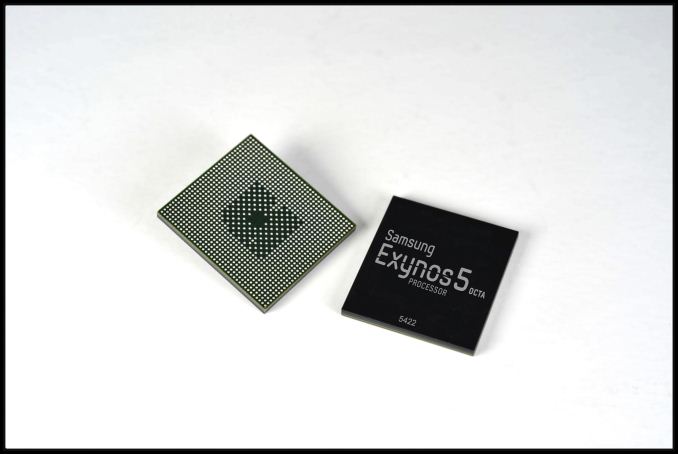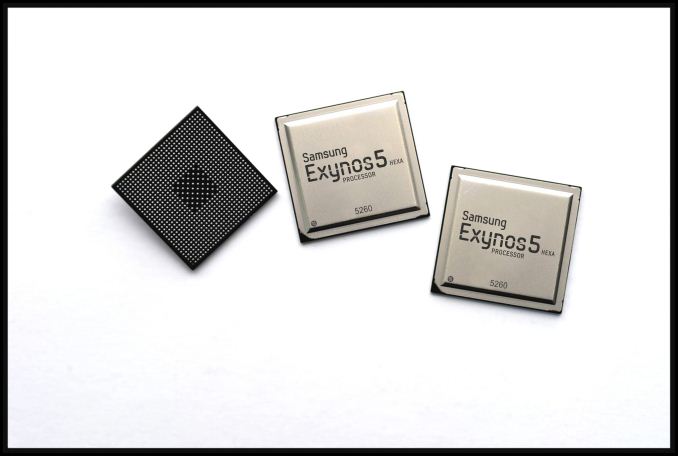Samsung's Exynos 5422 & The Ideal big.LITTLE: Exynos 5 Hexa (5260)
by Anand Lal Shimpi on February 25, 2014 9:00 PM EST- Posted in
- SoCs
- Samsung
- Smartphones
- Mobile
- Tablets
- exynos 5 octa
- Exynos 5 Hexa

Samsung announced two new mobile SoCs at MWC today. The first is an update to the Exynos 5 Octa with the new Exynos 5422. The 5422 is a mild update to the 5420, which was found in some international variants of the Galaxy Note 3. The new SoC is still built on a 28nm process at Samsung, but enjoys much higher frequencies on both the Cortex A7 and A15 clusters. The two clusters can run their cores at up to 1.5GHz and 2.1GHz, respectively.
The 5422 supports HMP (Heterogeneous Multi-Processing), and Samsung LSI tells us that unlike the 5420 we may actually see this one used with HMP enabled. HMP refers to the ability for the OS to use and schedule threads on all 8 cores at the same time, putting those threads with low performance requirements on the little cores and high performance threads on the big cores.
The GPU is still the same ARM Mali-T628 MP6 from the 5420, running at the same frequency. Samsung does expect the 5422 to ship with updated software (drivers perhaps?) that will improve GPU performance over the 5420.
| Exynos 5 Comparison | ||||||||
| SoC | 5250 | 5260 | 5410 | 5420 | 5422 | |||
| Max Number of Active Cores | 2 | 6 | 4 | 4 (?) | 8 | |||
| CPU Configuration | 2 x Cortex A15 | 2 x Cortex A15 + 4 x Cortex A7 | 4 x Cortex A15 + 4 x Cortex A7 | 4 x Cortex A15 + 4 x Cortex A7 | 4 x Cortex A15 + 4 x Cortex A7 | |||
| A15 Max Clock | 1.7 GHz | 1.7GHz | 1.6GHz | 1.8GHz | 2.1GHz | |||
| A7 Max Clock | - | 1.3GHz | 1.2GHz | 1.3GHz | 1.5GHz | |||
| GPU | ARM Mali-T604 MP4 | ARM Mali-T624 (?) | Imagination PowerVR SGX544MP3 | ARM Mali-T628 MP6 | ARM Mali-T628 MP6 | |||
| Memory Interface | 2 x 32-bit LPDDR3-1600 | 2 x 32-bit LPDDR3-1600 (?) | 2 x 32-bit LPDDR3-1600 | 2 x 32-bit LPDDR3-1866 | 2 x 32-bit LPDDR3-1866 | |||
| Process | 32nm HK+MG | 28nm HK+MG (?) | 28nm HK+MG | 28nm HK+MG | 28nm HK+MG | |||
The launch vehicle for the 5422 is likely the recently announced Galaxy S 5. Although most of what we'll encounter will ship with Qualcomm's Snapdragon 801, we'll likely see some international variants with the 5422. It's also entirely possible that some future Exynos 5422 SGS5 variants will feature an Intel XMM 7160 LTE modem.
The more exciting news however is the new Exynos 5 Hexa, a six-core big.LITTLE HMP SoC. With a design that would make Peter Greenhalgh proud, the Exynos 5260 features two ARM Cortex A15 cores running at up to 1.7GHz and four Cortex A7 cores running at up to 1.3GHz. The result is a six core design that is likely the best balance of performance and low power consumption. HMP is fully supported so a device with the proper scheduler and OS support would be able to use all 6 cores at the same time.
The 5260 feels like the ideal big.LITTLE implemention. I'm not expecting to find the 5260 in many devices, but I absolutely want to test a platform with one in it. If there was ever a real way to evaluate the impact of big.LITTLE, it's Samsung's Exynos 5260.
Samsung didn't announce cache sizes, process node or GPU IP for the 5260. Earlier leaks hinted at an ARM Mali T624 GPU. Samsung's release quotes up to 12.8GB/s of memory bandwidth, which implies a 64-bit wide LPDDR3-1600 interface.











35 Comments
View All Comments
name99 - Wednesday, February 26, 2014 - link
There whole POINT of the slow background tasks you describe is that they are SLOW.You do realize you can multitask multiple such tasks on a single CPU? I ask this in all seriousness because EVERY FREAKING TIME this issue comes up, 90% of the commenters act as though they do not understand and are completely unaware of this.
If the total CPU requirements of all your background tasks are less than the performance of a single A7 (and they damn well should be, otherwise you have a very crappy OS) then the optimal solution is a single core running all the tasks.
I'm with deltatux. only I'd be more extreme. Much like I stated when big.LITTLE was first announced, I STILL believe that for all realistic scenarios the only config that makes sense is a SINGLE slow companion core. nVidia don't get much right, but this was one they did get right.
The big.LITTLE matching core scheme is justifiable if you have a crappy OS (which WAS the case back then) which can't do a decent job of handling heterogenous cores, so you're using two cores to fake a single high dynamic range core. But it make no sense when you have a heterogenous-aware OS.
MrSpadge - Wednesday, February 26, 2014 - link
You can't use 4 A15's at the same time in a smartphone thermal envelope anyway, despite manufacturers putting them in. So running 2 of them at maximum frequency is hardly slower than 4 of them running at significantly reduced frequency.lagokc - Wednesday, February 26, 2014 - link
"You can't use 4 A15's at the same time in a smartphone thermal envelope anyway, despite manufacturers putting them in. "Nonsense. There just hasn't been a phone manufacture that's been willing to pack in a big enough heatsink and fan yet.
jimjamjamie - Wednesday, February 26, 2014 - link
Nvidia Shield 2 w/ closed loop water cooling! woopname99 - Wednesday, February 26, 2014 - link
Do you know this for a fact?There are three possible pain points:
- the temperature gets too high
- the power draw gets too high
- the power draw becomes "undesirable" ie short battery life.
The first two are nonnegotiable, the third is a matter of opinion, and some people might be happy with it, especially if connected to power.
My understanding was that the issue is the second and third points more than the first.
The first is an interesting point because if you allow for thermal inertia (ie like modern Intel) you get a few milliseconds to run everything at high speed, and that may be valuable for snappiness, although not for on-going performance.
jjj - Tuesday, February 25, 2014 - link
Odd to announce the 6 cores SoC after announcing a phone that is using it, the Samsung Galaxy Note 3 Neo.Gam3sTr - Tuesday, February 25, 2014 - link
Is the 5422 their flagship soc or are they going to announce an even better one this year?dylan522p - Tuesday, February 25, 2014 - link
They probably will have a A53/A57 one with 20nm at the end of the year for the Note 3.coder543 - Wednesday, February 26, 2014 - link
I think you mean Note 4?teiglin - Tuesday, February 25, 2014 - link
I suppose 5260 will be a good test, but I'm still not sold on big.LITTLE. The problem remains largely a software one because the DVFS is handled by the kernel, so it isn't totally insurmountable, but there needs to be some very serious vertical cooperation here in order to make big.LITTLE both as power-efficient and fast as it theoretically can be. I'm sure there's more room for simple kernel-only optimizations based on the phone state (power-saving mode, screen on, perhaps even connectivity). Perhaps there could be an application-level switch indicating whether a task is time-sensitive and should be performed on a big core (e.g. UI event handler) or lazier background work and can be performed on LITTLE cores (e.g. file transfers, synchronization). Still, that would put an additional onus on developers to write good, power-efficient mobile apps, which is already far too uncommon.Hopefully Samsung can get their CPU governors to a state where the UI never drops frames due to a core swap, but anecdotally--just comparing 5420 devices to their MSM8974 equivalents--they've got a long way to go.